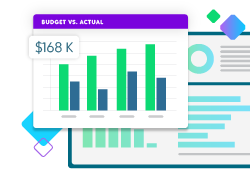Nonprofit Accounting vs. For-Profit Accounting: How They Are Different and Why Nonprofits Should Care

Accounting is an essential part of any ongoing enterprise. It is the meticulous process of recording and organizing financial transactions and is the backbone of the financial system for both nonprofit organizations and for-profit businesses. And while the fundamental principles of accounting remain constant across different entities, the way those entities approach accounting varies a lot based on the nature of their organization.
Every organization in existence, large or small, for-profit or nonprofit, must keep track of their transactional financial activity. It’s not an option. And while many aspects are the same between charitable entities and commercial businesses, other elements are quite different indeed, down to their very reason for existing. A nonprofit organization exists to fulfill a specific mission or purpose rather than earn a profit, while a business usually has profit maximization as its primary goal.
In this article, you will learn about the nuances of fund accounting, including the key differences between what nonprofits need and what for-profit businesses need, and the rationale for those differences.
Fund Accounting vs. Single Accounting System
While nonprofit and for-profit organizations share some foundational accounting principles, they diverge significantly in approach and purpose. Nonprofits emphasize accountability, fund segregation, and mission-driven financial transparency, whereas for-profits focus on unified systems and profitability for owners and shareholders.
Nonprofit Accounting
Nonprofit organizations typically use a fund accounting system, which segregates financial resources into separate funds, each dedicated to specific purposes or programs. This separation allows nonprofits to track the financial performance and accountability of each fund independently. Common funds in nonprofit accounting include the general fund, program funds, and restricted funds, each serving distinct objectives.
Imagine a nonprofit organization dedicated to improving education in underprivileged communities. They might have multiple funds, such as the “Scholarship Fund” to support students’ education expenses and the “Community Outreach Fund” for community engagement initiatives. By segmenting funds, the organization can ensure that donations and grants received for scholarships are used exclusively for that purpose, maintaining transparency and accountability.
For-Profit Accounting
By contrast, for-profit businesses typically use a single accounting system to record all financial transactions, regardless of their purpose. Unlike nonprofit fund accounting, there is usually no need to separate funds for different purposes, as the primary goal of a business is to generate profits for its owners or shareholders.
Consider a local ice cream shop. All the income generated from selling cones, shakes, and sundaes is recorded in a single accounting system. There is no segregation of funds based on specific activities or goals because the primary aim is to ensure the business remains profitable. Also, no customer is going to request a report showing the money they paid for their banana split only went to buy more bananas, so it doesn’t need to be tracked separately.
| Nonprofit Accounting | For-Profit Accounting | |
| System | Uses a fund accounting system to segregate resources by purpose or program. | Uses a single, unified accounting system for all financial transactions. |
| Purpose | Ensures transparency and accountability for each fund (e.g., general fund, restricted fund). | No need to separate funds by purpose—all revenue and expenses are combined. |
| Restrictions | Tracks donor and grantor restrictions to ensure proper use of designated funds. | Focuses on profitability and financial performance for owners or shareholders. |
| Examples | Example: A nonprofit may maintain separate funds for scholarships and community outreach, each tracked independently. | Example: A local ice cream shop records all product sales in one system without breaking down revenue by item type or customer. |
| Objective | Prioritizes mission fulfillment over profit. | Prioritizes maximizing profit rather than tracking fund-specific restrictions. |
Accounting Principles and Standards: FASB and GAAP for Nonprofits
Both for-profit and nonprofit organizations in the U.S. follow Generally Accepted Accounting Principles (GAAP), but how those principles are applied differs depending on the entity type.
For nonprofits, GAAP is interpreted through FASB (Financial Accounting Standards Board) guidance, particularly FASB ASC Topic 958, which is tailored specifically to nonprofit organizations. These standards recognize the unique nature of nonprofits—such as their lack of ownership structure and reliance on donor funding—and establish requirements around net asset classification, functional expense reporting, and enhanced disclosures.
While for-profits focus on profit and shareholder reporting, nonprofits must emphasize accountability and transparency, especially regarding restricted funds and resource availability. As a result, the accounting standards nonprofits follow may look familiar on the surface but are governed by a different set of expectations beneath the hood.
Revenue Recognition
Revenue recognition is more nuanced for nonprofits than it is for for-profit businesses. Nonprofit revenue is typically made up of one or more of the following: donations and grants, program fees (revenue generated from regular sales of goods and/or services, the sale of which directly furthers the exempt purpose of the organization), and investment income.
Nonprofits categorize donations and grant income as either “with donor restrictions” or “without donor restrictions.” This distinction is essential because certain funds can only be used for specific purposes as designated by the donor. Recognizing these differences ensures that funds are used appropriately and transparently.
Timing of revenue recognition can be unusual for nonprofits, as well. Nonprofits typically recognize revenue when it is earned and realizable, which can be different from when cash is received. An example of this concerns pledges received. If a pledge is uncertain, revenue is usually recognized when the gift is ultimately received. If a pledge is certain and irrevocable, revenue is recognized in the period the pledge is made by the donor, not when the promised gift is received.
Another nonprofit nuance involves multi-year grants. This can result in delayed revenue recognition, depending upon the grant requirements.
If a nonprofit organization receives a multi-year grant to support a three-year educational program, the revenue is recognized over the program’s duration. This concept is known as the matching principle. In this case, revenue recognition is tied to the program’s performance, even though the entire grant amount may have been received upfront.
For a for-profit business, revenue is recognized when a product is sold, or a service is rendered. For example, when a customer buys a product, the transaction is recorded as revenue for the business. That can look different depending on whether the organization uses the accrual or cash method of accounting. But there is no business version of restricted revenue or pledge accounting.
Financial Statements and Reporting
A business has specific financial statements that are fundamental to its accounting: the Income Statement (or Profit and Loss Statement), the Balance Sheet, and the Statement of Cash Flows.
Nonprofit fund accounting generates similar reports, but with important distinctions, including the naming convention. For example:
- The Income Statement is referred to as the Statement of Activities.
- The Balance Sheet is referred to as the Statement of Financial Position. Instead of an equity section on the Statement of Financial Position (Balance Sheet), nonprofits have “net assets,” which are further categorized based on donor restrictions.
- The Cash Flow Statement is similar but might have specific line items related to donations or grants.
- Another unique report for nonprofits is the Statement of Functional Expenses. This report categorizes expenses by function (program services, management and general, and fundraising). It’s required by Generally Accepted Accounting Principles (GAAP) and state/federal regulations. The SFE helps demonstrate how a nonprofit uses its resources and is a key part of their financial reporting.
A nonprofit’s Statement of Activities would also show the various sources of revenue, such as grants, donations, and program fees, as well as the corresponding expenses associated with each program or fund. This level of detail is essential for transparency and accountability in nonprofit organizations.
Compliance and Regulations for Nonprofit Accounting
Unlike for-profit businesses, nonprofit organizations are subject to a distinct set of compliance and regulatory obligations that reflect their tax-exempt status and public accountability.
IRS Form 990
Most nonprofits are required to file Form 990 annually with the IRS. This comprehensive informational return serves as a public disclosure document and includes:
- Details on the organization’s mission and programs
- Revenue, expenses, and functional expense breakdowns
- Governance practices
- Executive compensation
Form 990 is not just a compliance form—it’s also a transparency tool. Donors, grantmakers, and the public often review a nonprofit’s 990 to assess financial health and stewardship.
Tracking Funder Intent
A core compliance responsibility for nonprofits is adhering to donor restrictions. Funds received with stipulations—whether from individual donors or institutional grantmakers—must be:
- Tracked separately through fund accounting
- Used only for the purposes specified
- Reported clearly in financial statements and, where applicable, to the funders themselves
Failure to honor funder intent can jeopardize donor trust, damage reputations, and, in extreme cases, lead to regulatory penalties or loss of exempt status.
State-Level Requirements
In addition to federal oversight, nonprofits must comply with state-specific regulations, which may include:
- Charitable solicitation registration and renewal
- Annual financial report submissions (sometimes audited)
- Corporate filings to maintain good standing
Requirements vary significantly by state, so nonprofit finance leaders must monitor regulations in each jurisdiction where the organization operates or solicits donations.
Unrelated Business Income Tax (UBIT)
While nonprofits are generally exempt from income tax, they must pay taxes on unrelated business income—revenue from activities not substantially related to the organization’s exempt purpose. Examples include:
- Selling advertising space in a newsletter or on a website
- Operating a retail business unrelated to the mission
Nonprofits that generate UBIT must report it on Form 990-T and pay applicable federal and sometimes state income taxes.
Profits vs. Surpluses and How Financial Metrics Differ
For-profit companies aim to generate profits, which can be reinvested in growth or distributed to owners and shareholders. Profit is often the driving force behind the business itself. As a company grows, this emphasis becomes even more pronounced—publicly traded companies are legally bound to prioritize profit maximization on behalf of shareholders.
Nonprofits, on the other hand, do not generate “profits” in the conventional sense. When a nonprofit’s revenues exceed its expenses, the result is a surplus. But rather than being distributed, that surplus is reinvested into the organization to expand programs, improve services, or strengthen infrastructure in support of its mission.
Beyond profit vs. surplus, the financial metrics used to assess health and effectiveness also diverge:
Program Efficiency vs. Profit Margin
For-profits focus on profit margin—how much revenue remains after expenses—as a core indicator of financial success.
Nonprofits often emphasize program efficiency, or the percentage of total expenses spent directly on mission-related activities. A high program efficiency ratio suggests strong alignment between funding and purpose. A counterpoint to keep in mind is that efficiency shouldn’t be the enemy of effectiveness or growth. A hyper-focus on efficiency that doesn’t consider the needed investment in program effectiveness and organizational growth can prove to be a short-sighted strategy.
Operating Reserve vs. Working Capital
For-profits track working capital to measure liquidity and short-term financial flexibility.
Nonprofits manage an operating reserve—a designated surplus of unrestricted funds—to weather fluctuations in funding or support future strategic initiatives.
Return on Investment vs. Mission Impact
Businesses often evaluate performance using ROI (return on investment) or shareholder value.
Nonprofits are assessed by mission impact, such as how effectively programs meet goals or improve community outcomes—financials support, but do not define, success.
Understanding these contrasts is key for financial leaders transitioning between sectors or supporting organizations in both domains. While the tools may look similar, the purpose behind the numbers is fundamentally different.
Financial Management Challenges in the Nonprofit Sector
Managing finances in a nonprofit organization comes with a distinct set of challenges—many of which stem from the sector’s dual responsibility to remain fiscally sound while advancing a mission. Unlike their for-profit counterparts, nonprofit finance teams must constantly balance compliance, transparency, and operational flexibility—often with limited resources.
Here are some of the most common and persistent challenges nonprofits face:
Balancing Restricted and Unrestricted Funding
Nonprofits frequently rely on restricted contributions that must be used for specific programs or purposes. At the same time, they must cover operational expenses with unrestricted dollars, which are often harder to come by. This imbalance can create budget strain even when the organization appears well-funded on paper.
Cash Flow Management
Timing is everything. Revenue from grants or donations may be delayed, episodic, or tied to performance milestones. Without consistent inflows, nonprofits often face cash flow gaps that complicate payroll, vendor payments, and program continuity—especially in the absence of a healthy operating reserve.
Limited Accounting Staff and Expertise
Many nonprofits operate with lean internal finance teams, often with just one or two staff members wearing multiple hats. This limitation can stretch capacity and increase the risk of compliance issues or reporting errors. To fill the gap, some organizations turn to fractional CFOs or outsourced accounting services, which can offer cost-effective access to expertise.
Grant Management Complexity
Managing multiple grants—each with its own reporting requirements, spending restrictions, and deadlines—demands a high level of organization. Errors or delays can jeopardize future funding and damage credibility with funders.
Regulatory Compliance
Staying current with FASB updates, Form 990 requirements, state-level registrations, and other financial regulations requires dedicated attention. These rules are updated frequently and can vary by jurisdiction and funding source.
Demonstrating Impact vs. Financial Return
Unlike for-profit businesses that report on ROI, nonprofits must prove mission impact to donors, foundations, and the public. This means going beyond numbers to tell a compelling story about how financial resources translate into meaningful outcomes—while still adhering to rigorous accounting standards.
In short, nonprofit financial management is as much about strategy and storytelling as it is about spreadsheets and statements. Organizations that understand and adapt to these challenges are better equipped to remain resilient, credible, and mission-aligned.
Nonprofits Need Nonprofit Accounting Software
The overall health and success of both nonprofit organizations and for-profit businesses depend heavily on timely and accurate financial records. However, nonprofits face unique challenges that make specialized accounting software a necessity rather than a luxury.
Unlike generic commercial solutions, nonprofit accounting software is designed to accommodate the complexities of fund accounting, donor restrictions, and compliance requirements. It provides strategic advantages such as enhanced transparency, tailored reporting capabilities, and streamlined grant management—all of which are critical for advancing the mission while maintaining financial stability. Adopting software specifically built for nonprofits ensures that organizations can allocate resources efficiently, demonstrate impact effectively, and navigate financial intricacies with confidence.
To learn more about why nonprofits shouldn’t settle for commercial accounting software, check out our white paper, Why Nonprofit Organizations Need Nonprofit Accounting Software.
Fund Accounting Software that Drives Impact
Find out how Blackbaud’s Financial Edge NXT® fits your organization.



